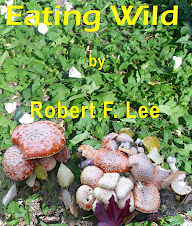Saturday, May 12, 2012
Preparing, Drying & Storing Herbs and Wild Plants
The proper preparation and storage of herbs and medicinal plants is critical to obtaining the most benefit from the desired remedy. While some of the methods of preparation and storage may seem complex, once you have undertaken and completed your first round of preparation, you will find that the process is quite simple and logical.
Three tools that you will find invaluable as you become more dedicated to “eating wild” are a juicer, dehydrator and drying screen for your harvested plants..
There are five primary methods of preparing herbs for medicinal use, plus an arsenal of alternative preparation & delivery methods. The five primary methods are infusion, decoction, tincture, extraction & distillation. Each method offers specific advantages.
By far, the easiest way to store many of your harvested plants simply is to dry them. However, freezing, refrigerating, canning and preparations of jams and jellies often also are viable alternatives.
Herbs are dried in a variety of ways, depending on the part of the plant used.
For leaves (particularly delicate leaves) and flowers, use a fiberglass screen on which the leaves are loosely arranged to allow for air movement. Place the screen in an area where sunlight is minimal, yet where there is moderate air movement. Turn the leaves at least two to three times over several days, until they are completely dry. For roots and seeds, herbs can be dried in direct sunlight. Where the entire plant (or stems, leaves and flowers) can be stored, hang the plant in a warm, dry shaded area for several days. For thicker, sugar-rich crops like most berries, use of a dehydrator is recommended to prevent the growth of mould.
Many wild herbs can be frozen, either in ice cubes, or by adding a small amount of water to the herbs and placing in freezer bags. Most herbs can be safely stored in the crisper of the refrigerator for up to a week.
Root crops and other low acid, high-density plants can be canned, by blanching for three minutes and sealing in sterilized jars (in the same way as vegetables are canned).
Jams and jellies all follow a couple of basic recipe patterns, with the only variation being the type of jam being made. Moisture-rich jellies require slightly less liquid to be added, while pectin and gelatine provide the thickening agent. Apple juice, stevia (an herb) or sugar provide much of the sweetener.
Wild plants (and domestic ones) that are intended for use as medicinal remedies should be prepared with the intended use in mind.
Infusions are the simplest methods of garnering the oils from an herb. Infusions are prepared by combining a small amount (1-2 teaspoons or 10 grams) of dried herb per cup of boiling water. If using fresh herbs, double the amount of herb used. Do not boil the herb in the water. Instead, pour the water over the herb and allow it to stand. Infuse, or “steep” the mix for 10 minutes and strain. If steeped too long, the infusion will taste bitter. Be sure not to use metal pots or containers for storage, or even for infusing, for safety and taste.
Infusions are best used immediately, with herbs stored as a dry product until required. Because of their short and simple preparation time, there is no need for advanced preparation in a carrier.
Decoctions are prepared in much the same way as an infusion. However, since decoctions are used for harder herbs, plant stems, roots, seeds and bark, the plant must be exposed to boiling water for a prolonged period (typically 20-45 minutes) to extract the vital ingredients, the herb is placed in the water and boiled, rather than steeped. This tends to result in a more bitter taste. The ratio of water to herb in decoctions generally averages about 20 to 1.
Although the water must be a boiling temperature (212F or 100C), it need not be a rolling boil. Instead, simmer the mix for the required period of time. Once the herb has decocted, strain the liquid, discarding the solids. Drink by mixing with a small amount of sweetener. Decoctions may be stored in a refrigerator for up to a week, but are best used immediately.
While prepared in much the same way as decoctions and infusions, tinctures use alcohol to extract the essential ingredients from the plants being processed.
A second, and critical, difference between tinctures and infusions is that the solvent alcohol is not heated. Alcohol has an extremely low flash point, and serious injury can occur if the alcohol is heated beyond its flash point.
It is imperative to note that tinctures use ethyl alcohol, not wood or methyl alcohol. Any product taken internally must not use methyl alcohol, as this type of alcohol can cause blindness or even death. Although some tinctures are applied topically or externally, it is best to always use ethyl alcohol for tinctures.
Pure, non- denatured ethyl alcohol is not readily available. However, and alternative is to use vodka or other high-alcohol-percentage unflavored beverage mixed 3:2 with water, for tinctures.
Mix seven to nine cups of fresh herbs (or 4 cups of dried herb) and with blend 4-41/2 cups of water/alcohol mix. If using fresh herbs, lightly crush the plant to assist in breaking the essential oils free from the plant. Place the herbs in a ceramic or glass container and cover with the liquid. Place a lid on the container and store in a dark, cooler place for up to a month. Shake or stir the mix daily. At the end of the month, strain the liquid into a dark glass or ceramic container with a lid. These tinctures may be stored for between six months to 2 years.
Oils and essential ingredients in herbs may be removed through simple extraction (the other primary methods also are extractions, using carriers or solvents). Simple extraction involves crushing the herb using a mortar and pestle, a small commercial cold press, a centrifuge system or hammer mill. Generally, simple extraction involves quantities and equipment beyond the access of most home herbalists.
Distillation involves evaporation of water/herb mixes in much the same way as a brewer makes home brew. The process involves mixing the herbs and water (or herbs and alcohol), and, using a closed or open loop system, boiling off the liquid at a controlled temperature until a concentrate of the herb remains. For alcohol distillation, the temperature is 70C (158F). At this temperature, only the alcohol will evaporate, leaving a syrupy mix of herbs and liquid. For water distillation, the water is evaporated until a minimal amount of concentrate remains, which is then filtered or strained and stored.
Distillation requires equipment that is not readily available to the home herbalist, and, in some jurisdictions, is not legal to own or use.
Oil infusions generally are for external use only. However, if a more moderate essential oil or an herb that is less volatile or potentially dangerous is combined with edible oils such as olive, almond, sunflower, or canola oil, the infusion may be used internally in moderate doses.
Oil infusions can be prepared using the same method as water infusions, with the exception that the time to steep or simmer the infusion should be at least 5-6 times that of simple water infusions. Oil infusions can be prepared by letting the mixes stand, in a warm area (in a dark glass container), for several months. Once readied, move to a cooler, darkened area. Note that food-grade oils deteriorate, or sour, relatively quickly, if stored in direct light or warm areas.
Liniments are made using alcohol or oil and a warming herb, such as cayenne, cloves, eucalyptus, ginger, peppermint or spearmint, marjoram (tarragon) or wintergreen. The advantage of using alcohol is its tendency to cool the skin as it evaporates, providing the hot/cold effect employed in various commercial muscle relief treatments. Oils used must be vegetable oils, to facilitate absorption into the skin.
Herbal wines and vinegars are easy to prepare, and make great decorative pieces. Simply mix the required herbs (about 1:4 herb to liquid) with white, balsamic, rice or red wine vinegar and store in a bottle. If making wine, add a preferred amount of herbs to a red wine. For mints and delicate herbs, use a white wine. Leave at least two weeks before using.
More bitter or harsh tasting medicinal herbs are often prepared as a syrup, or distilled & boiled to make candies. Sugar acts as a great preservative, and, as espoused in Mary Poppins, a spoonful of sugar makes the medicine go down.
Add 2 cups of brown sugar or honey to 2 cups of the herb infusion or decoction, heat on low until almost the sugar dissolves and the mixture thickens, then pour into a clean, thick glass container and store in the refrigerator.
To prepare creams, use oil, beeswax and water. Add one cup of olive or almond oil to 50 grams of beeswax in a double boiler. Add 50 grams of fresh herb and a few tablespoons of water. Mix and simmer for 20 minutes. Strain through a fine sieve and store in sterilized jars with lids.
If making an ointment, use petroleum jelly or baby oil instead of vegetable oil, and simmer until the herbs break down.
For a lotion, blend 3 ounces (84 g) of carrier vegetable oil (olive, grape seed, almond), 2 ounces (56 g) melted cocoa butter and two ounces of the prepared herb infusion and store in ceramic or dark-colored glass containers. Vegetable oils will “sour” if left in light or heat for prolonged periods, so be sure to prepare only enough to be used in two weeks. Epsom salt blends provide the therapeutic element of muscle relaxation, while oil blends provide skin softening & protective layering. Oatmeal bath is often used to treat burn patients when damaged skin is being removed, or to soothe pain. On the other hand, oil baths, particularly made using oil infusion or essential oil concentrate, eliminate the particulate found in dry herb. To make oil blends, simply add the required amount of essential oil to an absorbable oil carrier, such as almond, grape extract or olive oils. To make Epsom salt blends, grind the mix of dried herbs and Epsom salts together in a food grinder or blender until fine.
Compresses involve using a cloth soaked in hot herb infusions, tinctures or decoctions, applied directly to a wound or affected area.
Poultices involve chopped, crushed or powdered herbs boiled in water to make a pulp. The pulp is then wrapped in a thin, porous cloth and applied to the injured area. Apply a light layer of cream or oil to the wound to prevent sticking of the poultice, if necessary. Common poultices from pioneer days included mustard poultices applied to the chest for colds, or common plantain or garlic poultices applied to injuries and sprains.
Subscribe to:
Posts (Atom)

